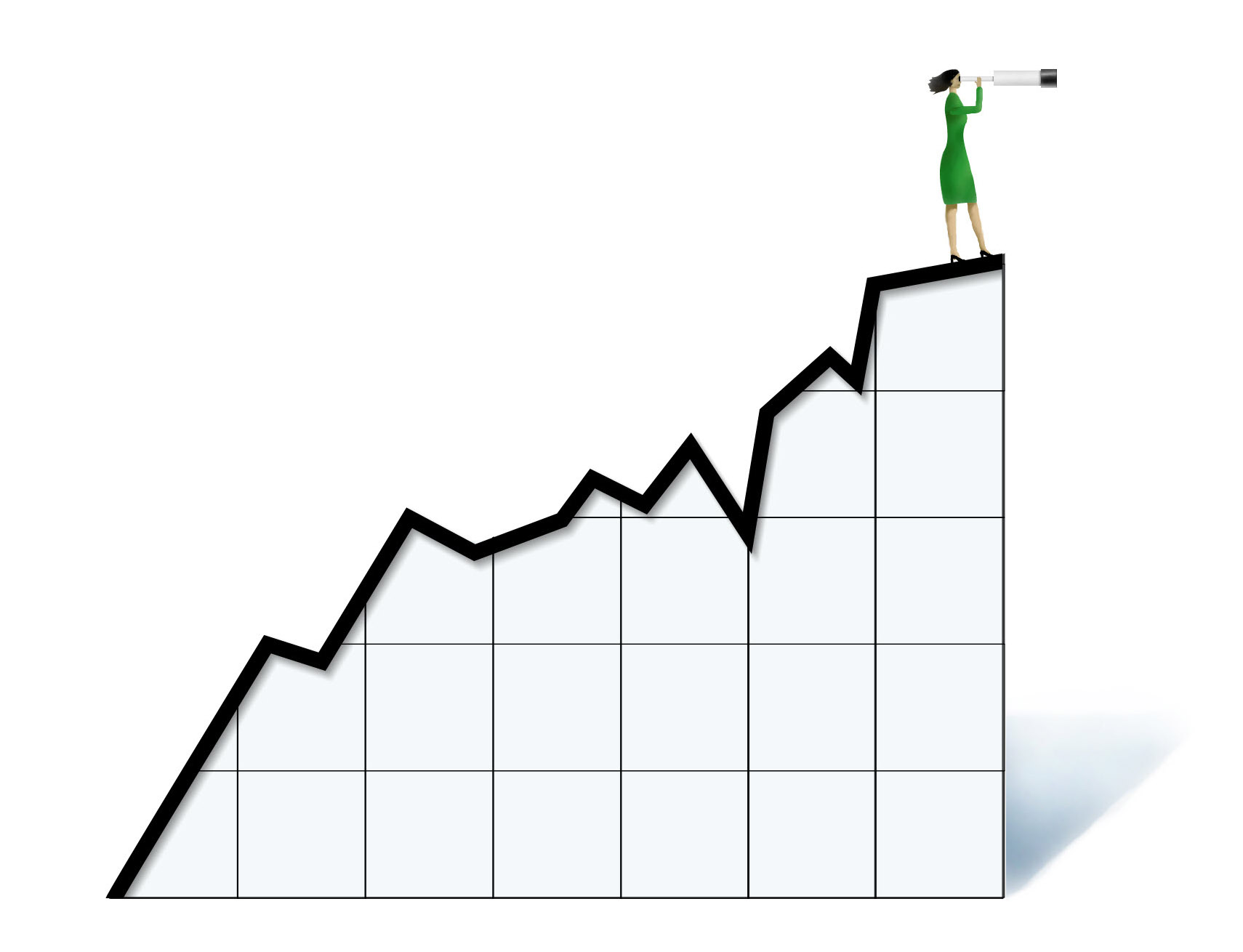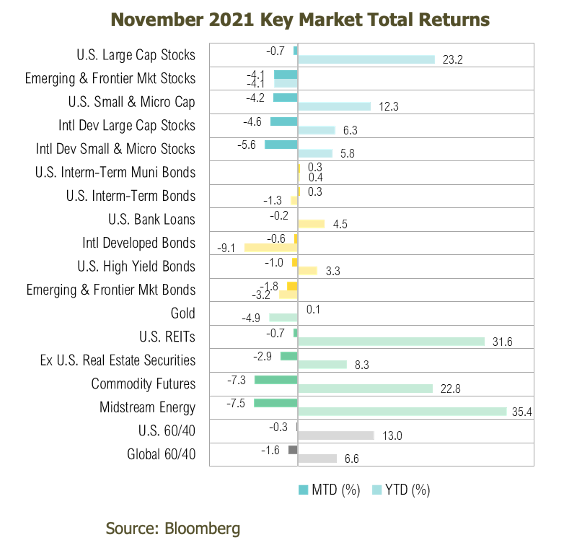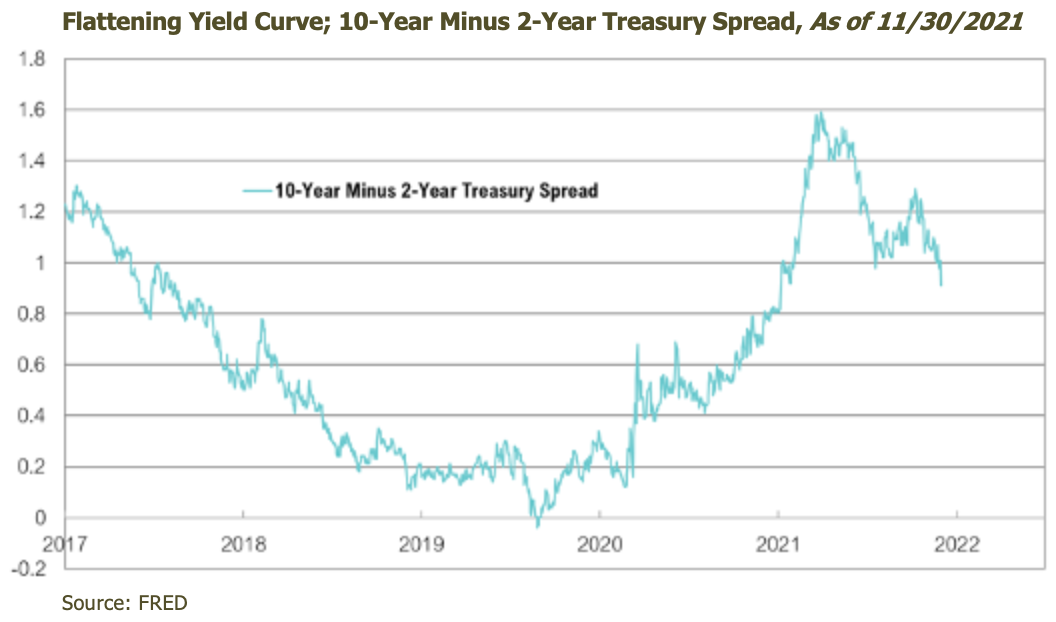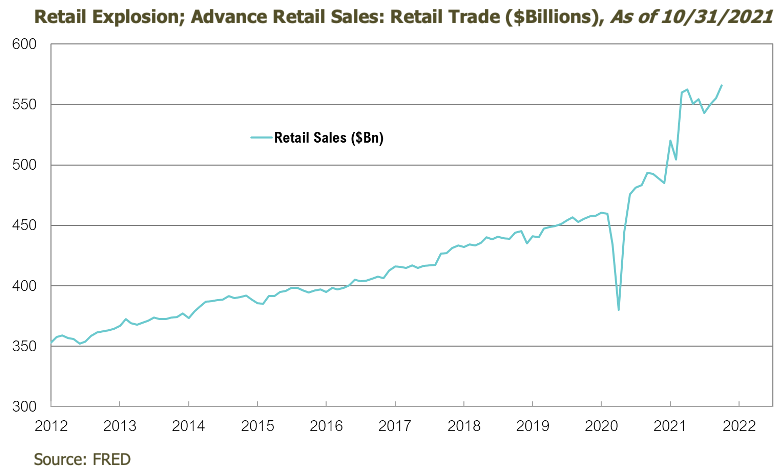Markets
Following its best month of the year in October, the S&P 500 Index cooled off in November, falling 0.7%. The shift in performance was concentrated at the end of the month. The index fell 2.6% from November 24 to November 30 as news of the Omicron COVID variant swept the globe.1 Even though the World Health Organization (WHO) indicated it was too early to determine the impact of the new variant, markets were roiled nonetheless by reports of rapid spread and “heavily mutated characteristics."2 Insult was added to injury at the end of the month as Federal Reserve Chairman Jerome “Jay” Powell acknowledged inflation was becoming a more “persistent” risk and suggested an earlier-than-expected end to the extraordinarily loose monetary policy that investors have become accustomed to.3
Despite less-than-stellar absolute performance, U.S. large cap stocks held up better than international stocks. The MSCI EAFE index dropped 4.6% over the month. Europe’s COVID case count has risen dramatically over the past several weeks, hitting an all-time high in 7-day average new cases per capita—more than double the per capita amount in the United States.4 This most recent spike has resulted in increased restrictions across the continent, including partial or full lockdowns issued in the Netherlands and Austria.5
The increased likelihood of global government-imposed restrictions did not bode well for the energy sector. After starting the month at $83/barrel, WTI Crude closed the month at $66/barrel, a 20% decline.6 Natural gas and gasoline prices also tumbled, both falling 18% over the month.7,8 Midstream energy companies, which are usually more correlated to overall energy consumption than traditional energy producers, dropped 7.5%. Finally, despite a volatile month, gold finished up 0.1%.
On November 22, the White House announced President Biden’s intent to nominate Fed Chair Powell for a second term. The release praised Powell, citing his “steady leadership during an unprecedently challenging period.” Lael Brainard was appointed as Vice Chair and will report directly to Powell.9 As the only Democratic governor on the board today, she is viewed as the heir apparent to the next Democratic Fed nomination.10
On November 30, a newly renewed Powell appeared before a Senate committee and hinted that he would consider “wrapping up the taper of our asset purchases…perhaps a few months sooner.” When asked if “transitory” was still an appropriate word to describe the nature of the current inflationary episode, he conceded “it’s probably a good time to retire that word.”11 Federal Funds futures contracts, a market-based proxy for the expected future path of interest rates, quickly priced in the first rate hike in June 2022, and a second hike is now expected to occur before the end of 2022.
Within fixed income markets, the U.S. treasury curve, a revered gauge of expected economic growth, flattened as long-term interest rates fell and short-term rates rose over the month. The 10-year treasury rate slid from 155 to 143 basis points, and the 2-year rate increased from 48 to 52 basis points, bringing the spread between them to just 91 basis points, the lowest since January 2021.12
Omicron Variant
The Omicron coronavirus variant was first identified in South Africa on November 24 from samples collected nearly two weeks prior.13 Since its identification, it has been detected in multiple European countries, the United States, Australia, Brazil, Canada, Hong Kong, Israel, Japan, Nigeria, Norway, South Korea, Sweden, and the United Kingdom.13 Although little is known for sure about its transmissibility and severity, policymakers around the world responded to the potential threat with swift travel restrictions focused on southern Africa.14 The COVID-19 Stringency Index for the U.S., which had been steadily declining, began to increase once more, a reflection that restrictions were on the rise. This composite measure, created by the University of Oxford, tracks various response indicators including school closures and travel bans, using a range from 0 (no restrictions) to 100 (maximum restrictions). It reached a peak of 75 in November 2020 and hit a low of 45 in mid-November 2021. By the end of the month, however, it had increased 11% to 50. Similar moves were echoed around the world.15
Retail Sales
On November 16, the U.S. Census Bureau reported that retail sales rose by a seasonally adjusted 1.9% in the prior month to over $565 billion, as consumers bested the previous monthly spending record set in April 2021.16 This stands in stark contrast to the height of the pandemic, when monthly retail sales dipped to under $380 billion in April 2020, their lowest since February 2014.16 Since then, a flood of both monetary and fiscal stimulus has helped households accrue an estimated $2 trillion in excess savings over the course of the pandemic.17 The resulting spending frenzy has been more than enough to ward off any threat of a retail recession, and retail expenditures are now 23% above their pre-pandemic levels.16 Among the biggest monthly increases were online retailers (+4.0%) and electronics (+3.8%) as consumers continued to feed the post-COVID e-commerce explosion.18 Online spending is up nearly 40% from pre-pandemic levels, and it now accounts for 16.2% of all consumer purchases. Gas stations also saw a sizable increase (+3.9%) from the month before, although much of that can be attributed to rising gasoline prices during October. Higher inflation is undoubtedly eroding a portion of the increased sales, but sales are still rising faster than prices. After adjusting for inflation, retail sales were up a healthy 0.7% in October from the previous month and up 9.5% from a year earlier.19
Supply-chain bottlenecks—stemming from COVID-related inventory and labor shortages—have contributed to higher prices and resulted in longer-than-expected delivery times on retail orders.20 With the holiday season fast approaching, economists have warned that the bump in retail activity may be the result of consumers trying to get ahead of potential delivery issues by ordering their presents early.19
Despite strong retail spending, consumers are increasingly pessimistic about the economy. In early November, the University of Michigan consumer sentiment survey fell to its lowest reading in a decade.21 In the monthly report, the most popular response explaining the drop in sentiment was “higher prices,” indicating that consumers were worried about persistent inflation, which hit its highest monthly rate (+6.2% on a year-over-year basis) in over three decades in October.22
Looking Forward
Across the globe, communities continue to recover from the effects of the COVID-19 pandemic and lockdowns, but challenges persist. While we know little about the Omicron variant, recent waves of travel bans and other government-imposed restrictions serve as a reminder that significant and unpredictable policy responses will likely continue.
Although record levels of stimulus were initially welcome and likely necessary, continued stimulus—exacerbated by a multitude of supply chain issues—has led to overheating and significant inflation in parts of the economy. Attempts by the Fed to talk down inflation and the renewed travel bans may temporarily tamp down prices, but they will have offsetting impacts on already strained global supply chains. Further, the recent release of 50 million barrels of oil from the Strategic Petroleum Reserve in an attempt to “lower prices [of gasoline] for Americans” suggests market vigilantes—whether they represent bond, oil, or other markets—will have their work cut out for them.23 For now, at least, the Fed’s actions speak louder than words, and we believe that is what investors should focus on.
At RMB, we continue to recommend maintaining diversified portfolios of investments that have the potential to perform well in a broad range of market outcomes. As we approach the end of this year and look to the next, uncertainty surrounding economic recovery remains and concern over long-term inflation grows. Consumers are still facing higher prices and long delivery times, as shortages within the labor market and supply chain have made delivery of goods difficult for companies. Many investors view these issues as a sign that the inflationary pressures seen over the last six months are likely to continue in coming months. With the news of the new COVID variant, Omicron, corrections in equity markets and continued interest rate volatility remain a possibility in this environment. Given this, RMB believes investors should evaluate risk exposures in portfolios. One way for investors to respond in this type of environment is to maintain long-term asset allocation targets to stocks and bonds, but to reduce risk through a focus on high quality core investments within these allocations. While remaining cognizant of the increasing risks, we continue to focus on balancing opportunities in the current environment and taking advantage of niche markets that present attractive risk/reward opportunities.
2WHO: https://www.who.int/news/item/28-11-2021-update-on-omicron
4NYT: https://www.nytimes.com/interactive/2021/world/covid-cases.html
6Macrotrends: https://www.macrotrends.net/2516/wti-crude-oil-prices-10-year-daily-chart
7EIA: https://www.eia.gov/dnav/ng/hist/rngwhhdD.htm
8MarketWatch: https://www.marketwatch.com/investing/future/rb00
11Bloomberg: https://www.bloomberg.com/news/articles/2021-11-30/powell-says-appopriate-to-weigh-earlier-end-to-bond-buy-tapering
12FRED: https://fred.stlouisfed.org/series/T10Y2Y
14CNN: https://www.cnn.com/travel/article/new-covid-variant-travel/index.html
15Our World in Data: https://ourworldindata.org/grapher/covid-stringency-index?tab=chart&country=~USA
16FRED: https://fred.stlouisfed.org/series/RSXFS#0
17WSJ: https://www.wsj.com/articles/us-economy-october-2021-retail-sales-11637009365
18Census: https://www.census.gov/retail/marts/www/marts_current.pdf
19NYT: https://www.nytimes.com/2021/11/16/business/retail-sales-october.html
20IMF: https://blogs.imf.org/2021/10/25/longer-delivery-times-reflect-supply-chain-disruptions/
21University of Michigan: https://data.sca.isr.umich.edu/fetchdoc.php?docid=68530
All market pricing and performance data from Bloomberg, unless otherwise cited. Asset class and sector performance are gross of fees unless otherwise indicated.
The opinions and analyses expressed in this newsletter are based on RMB Capital Management, LLC’s (“RMB Capital”) research and professional experience, and are expressed as of the date of our mailing of this newsletter. Certain information expressed represents an assessment at a specific point in time and is not intended to be a forecast or guarantee of future results, nor is it intended to speak to any future time periods. RMB Capital makes no warranty or representation, express or implied, nor does RMB Capital accept any liability, with respect to the information and data set forth herein, and RMB Capital specifically disclaims any duty to update any of the information and data contained in this newsletter. The information and data in this newsletter does not constitute legal, tax, accounting, investment or other professional advice. Returns are presented net of fees. An investment cannot be made directly in an index. The index data assumes reinvestment of all income and does not bear fees, taxes, or transaction costs. The investment strategy and types of securities held by the comparison index may be substantially different from the investment strategy and types of securities held by your account. The S&P 500 Index is widely regarded as the best single gauge of the U.S equity market. It includes 500 leading companies in leading industries of the U.S economy. The S&P 500 focuses on the large cap segment of the market and covers 75% of U.S. equities. The Bloomberg Barclays U.S. Aggregate Bond Index is a broad based benchmark that measures the investment grade. The Bloomberg Commodity Indices (BCOM) are a family of financial benchmarks designed to provide liquid and diversified exposure to physical commodities via futures contracts. The Consumer Price Index (CPI) is a measure of the average change over time in the prices paid by urban consumers for a market basket of consumer goods and services. Indexes are available for the U.S. and various geographic areas. Average price data for select utility, automotive fuel, and food items are also available The Russell 1000® Growth Index measures the performance of the large- cap growth segment of the US equity universe. It includes those Russell 1000® companies with higher price-to-book ratios and higher forecasted growth values. The Russell 1000® Value Index measures the performance of the large cap value segment of the US equity universe. It includes those Russel 1000® companies with lower price-to-book ratios and lower expected growth values. The Russell 2000® Value Index measures the performance of small-cap value segment of the US equity universe. It includes those Russell 2000® companies with lower price-to-book ratios and lower forecasted growth values The Russell 2000® Growth Index measures the performance of the small- cap growth segment of the US equity universe. It includes those Russell 2000® companies with higher price-to-value ratios and higher forecasted growth values. The MSCI EAFE Index is an equity index which captures large and mid cap representation across 21 Developed Markets countries around the world, excluding the US and Canada. The Bloomberg Barclays 1-10 Year Municipal Blend Index is a market value-weighted index which covers the short and intermediate components of the Barclays Municipal Bond Index—an unmanaged, market value-weighted index which covers the U.S. investment-grade tax-exempt bond market. The Bloomberg Barclays US Corporate High Yield Bond Index measures the USD-denominated, high yield, fixed-rate corporate bond market.











